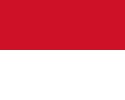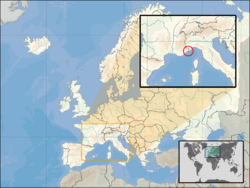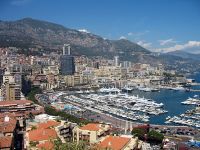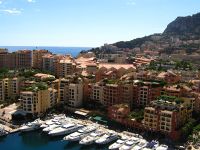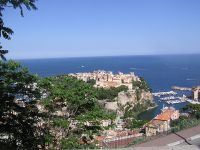Monaco
| Principauté de Monaco Principality of Monaco | |||||
| |||||
| Motto: "Deo Juvante" (Latin) "With God's Help" | |||||
| Anthem: Hymne Monégasque | |||||
| Capital | Monaco-Ville (de facto)1 43°44′N 7°24′E | ||||
|---|---|---|---|---|---|
| Official languages | French2 | ||||
| Government | Constitutional monarchy (Principality) | ||||
| - Prince | Albert II | ||||
| - Minister of State | Jean-Paul Proust | ||||
| Independence | |||||
| - House of Grimaldi | 1297 | ||||
| Area | |||||
| - Total | 1.95 km² (231st) 0.75 sq mi | ||||
| - Water (%) | 0.0 | ||||
| Population | |||||
| - 2006 estimate | 35,657 | ||||
| - 2000 census | 32,020 | ||||
| - Density | 18,285/km² 47,358/sq mi | ||||
| GDP (PPP) | 2007 estimate | ||||
| - Total | $976 million | ||||
| - Per capita | $67,000 (50000 Euros)(April 07 est.) | ||||
| HDI (2003) | n/a (n/a) | ||||
| Currency | Euro (EUR)
| ||||
| Time zone | CET (UTC+1) | ||||
| - Summer (DST) | CEST (UTC+2) | ||||
| Internet TLD | .mc | ||||
| Calling code | +377 | ||||
| 1 Monaco is a city-state. 2 Monégasque, English, and Italian are also spoken. | |||||
The Principality of Monaco (French: Principauté de Monaco), more commonly known as Monaco, is a constitutional monarchy and city-state in Western Europe located along the French Riviera between the Mediterranean Sea and France. It is one of six microstates located in Europe.
Monaco is the world's most densely populated country and second-smallest independent nation; with a population of just 32,410 and an area of 1.96 square kilometers (485 acres), Monaco is the world's smallest French-speaking sovereignty.
Geography
The Principality of Monaco is the second-smallest independent state in the world, after Vatican City. It is located on the Mediterranean coast, 18 kilometers (11 mi) east of Nice and near the Italian border. It is surrounded on three sides by France (Provence-Alpes-Côte d'Azur Région). It consists of a narrow strip along the coast at the bottom of the foothills of the Alps and its highest point is "Le Rocher" at 141 meters (459 ft).
The principality is noted for its natural scenery and mild, sunny climate. The average minimum temperature in January and February is 8°C (47 °F); in July and August the average maximum temperature is 26 °C (78 °F).
Monaco is a narrow coastal strip. Its physical geography includes a long beach and steep cliffs that rise vertically upwards to heights of 63 meters (206 ft) above sea level.
Administrative division
The distinction between State and City of Monaco is purely theoretical. The state in fact consists of one municipality (commune) only. According to the constitution of 1911, the principality was subdivided into three municipalities:
- Monaco (Monaco-Ville, the old city on a rocky promontory extending into the Mediterranean, known as the Rock of Monaco, or simply le Rocher (the rock), where the palace is located
- Monte Carlo, the principal residential and resort area with the casino in the east and northeast
- La Condamine, the northwest section including the port area
The three municipalities were merged into one in 1917 (after accusations that the government was acting according to the motto "divide and conquer"), and they had the status of wards (quartiers) thereafter.
- Fontvieille was added as fourth ward, a newly constructed area reclaimed from the sea (in the 1970s)
- Moneghetti became the fifth ward, created from a part of La Condamine
- Larvotto became the sixth ward, created from a part of Monte Carlo
- La Rousse/Saint Roman (including Le Ténao) became the seventh ward, also created from a part of Monte Carlo
Subsequently, three additional wards were created:
- Saint Michel, from a part of Monte Carlo
- La Colle, from a part of La Condamine
- Les Révoires, from a part of La Condamine
An additional ward is planned by new land reclamation, to be settled from 2014:
- Le Portier
Currently the principality is subdivided into 10 wards (with their official numbers - Le Portier, the planned ward, is anticipated as number 11):
For statistical purposes, the wards of Monaco are further subdivided into 173 city blocks (îlots), which are comparable to the census blocks in the United States.
History
Monaco apparently first gained its name from the nearby Phocaean Greek colony of Marseille, in the sixth century B.C.E., which referred to the Ligurians as Monoikos, from the Greek Μόνοικος — μόνος + οίκος, "single house", which bears the sense of a people either settled in a "single habitation" or of "living apart" from others. According to an ancient myth, Hercules passed through the Monaco area. A temple was constructed there by Phoceans, the temple of Hercules Monoikos.
Following a land grant from Emperor Henry VI in 1191, Monaco was re-founded in 1228 as a colony of Genoa. Monaco has been ruled by the House of Grimaldi since 1297, when François Grimaldi ("Malizia", "The Malicious") and his men captured the fortress protecting the famous Rock of Monaco while he was dressed as a Franciscan monk – or, in Italian Monaco, although this is a coincidence as the area was already known by this name.
From 1793 to 1814, Monaco was under French control. The Congress of Vienna designated Monaco as a protectorate of the Kingdom of Sardinia from 1815 until 1860 when the Treaty of Turin ceded to France the surrounding county of Nice (as well as Savoy). During this time there was unrest in the towns of Menton and Roquebrune, which declared independence, hoping for annexation by Sardinia. The unrest continued until the ruling prince gave up his claim to the two towns (some 95% of the country) to France in return for four million francs. This transfer and Monaco's sovereignty was recognised by the Franco-Monegasque Treaty of 1861.
Until the 1911 constitution, the princes of Monaco were absolute rulers. In July 1918, a treaty was signed providing for limited French protection over Monaco. The treaty, part of the Treaty of Versailles, established that Monegasque policy would be aligned with French political, military, and economic interests.
Rainier III, Prince of Monaco acceded to the throne following the death of his grandfather, Prince Louis II, in 1949. A new constitution, proclaimed in 1962, abolished capital punishment, provided for women's suffrage, and established a Supreme Court to guarantee fundamental liberties. In 1993, Monaco became a member of the United Nations, with full voting rights.
In 2002, a new treaty between France and Monaco clarified that if there are no heirs to carry on the dynasty, the principality will remain an independent nation rather than revert to France. Monaco's military defence, however, is still the responsibility of France.
By 31 March 2005, Prince Rainier III had become too ill to exercise his duties and relinquished them to his son Prince Albert, Marquis of Baux. On 6 April 2005, Prince Rainier died and his son succeeded him as Albert II of Monaco. Prince Albert II of Monaco formally became the ruler of Monaco on 12 July 2005, in a celebration that began with a solemn Mass at the cathedral where his father was buried three months before, after a reign of fifty-six years. His accession to the throne was a two-step event with another ceremony drawing heads of state for an elaborate ceremony held on 19 November 2005. He is the son of the late actress and princess Grace Kelly.
Law and government
Monaco has been governed as a constitutional monarchy since 1911, with the Sovereign Prince of Monaco as head of state. The executive branch consists of a Minister of State (the head of government), who presides over a four-member Council of Government (the Cabinet). The minister of state is a French citizen appointed by the prince from among candidates proposed by the French government. Under the 1962 constitution, the prince shares his power with the unicameral National Council (parliament). The twenty-four members of this legislative body are elected from lists by universal suffrage for five-year terms. The principality's local affairs are directed by the Communal Council, which consists of fifteen elected members and is presided over by the mayor
Monaco became a member of the United Nations in 1991, and received its first foreign diplomatic representative on 16 February 2006, when a French Ambassador was accredited to the Principality.
On both a per-capita and per-area basis, Monaco has the largest police force and police presence in the world.
The Compagnie des Carabiniers du Prince (Prince's Company of Carabiniers) is the military force of Monaco. Although Monaco's defence is the responsibility of France, it maintains a small force for the protection of the Sovereign Prince of Monaco. It was formed by Prince Honoré IV in 1817 for the protection of the Principality. The company numbers approximately one hundred officers and men; while the NCOs and soldiers are local, the officers have generally served in the French Army. Together with the local fire service, the Carabiniers form Monaco's total public forces. In addition to their guard duties, the company patrols the Principality's beaches and coastal waters, as well as other duties around the Palace in Monaco-Ville.
Economy
One of Monaco's main sources of income is tourism; each year many are attracted to its casino and pleasant climate. In 2001, a major new construction project extended the pier used by cruise ships in the main harbour. The principality has successfully sought to diversify into services and small, high-value-added, non-polluting industries such as cosmetics and biothermics.
As befits a world leader in glamour and money, Monaco is one of the most expensive places on Earth. As of February 2007, Monaco had Europe's most expensive real estate, ahead of even London. The principality is often regarded as a tax haven, and most of its inhabitants are millionaires from other countries. The glamour and prestige associated with Monaco and its style-conscious people can be seen in the number of high class cars, designer fashion boutiques such as Chanel, trendy restaurants, and its royal family, especially since the marriage of Prince Rainier to Grace Kelly, later HSH Princess Grace of Monaco.
The state retains monopolies in numerous sectors, including tobacco and the postal service. The telephone network (Monaco Telecom) used to be owned by the state; it now owns 45%, while the remaining 55% is owned by Cable and Wireless (49%) and Compagnie Monégasque de Banque (6%). It is still, however, a monopoly. Living standards are high, roughly comparable to those in prosperous French metropolitan areas.
Monaco is not a member of the European Union but is very closely linked to it via a customs union with France, and as such its currency is the same as that of France: the euro. Prior to 2002, Monaco minted their own franc coins, the Monegasque franc. Monaco has acquired the right to mint euro coins with Monegasque designs on their national side.
Tax Haven
The State has no income tax for individuals. The lack of personal income tax has led to a considerable number of wealthy "tax refugee" residents from European countries, who earn the majority of their income from activity outside Monaco; celebrities such as Formula One drivers attract most of the attention, but the majority of them are business people.
In 2000, a report by French parliamentarians Arnaud Montebourg and Vincent Peillon alleged that Monaco has lax policies with respect to money laundering, including within its famed casino, and that the government of Monaco puts political pressure on the judiciary so that alleged crimes are not properly investigated.
The Organisation for Economic Co-operation and Development (OECD) issued in 1998 a first report on the consequences of the tax havens financial systems. Monaco does not appear in the list of these territories until 2004, when OECD became indignant regarding the Monegasque situation [1] and denounces it in its last report[2] (as well as Andorra, the Principality of Liechtenstein, Liberia and the Republic of the Marshall Islands) underlining its lack of co-operation as regards financial information disclosure and availability.
In 2000, the Financial Action Task Force (FATF) underlined that Monaco suffers a great lack of adequate resources[3]. The Principality is no longer blamed in the FATF 2005 report[4], as well as all other territories in 2006[5].
Since 2003, the International Monetary Fund (IMF) has identified Monaco, along with 36 other territories, as tax havens[6].
The Council of Europe also decided to issue reports naming tax havens. 22 territories, Monaco included, were thus evaluated between 1998 and 2000 on a first round. Monaco is the only territory that refuses to perform the second round, initially forecast between 2001 and 2003, whereas the 21 other territories are implementing the third and last round, planned between 2005 and 2007[7]
Education
Schools
Monaco has ten state-operated schools, including seven nursery and primary schools, one secondary school (Collège Charles III), one lycée that provides general and technological training (Lycée Albert 1er, which compares favorably to those in neighboring southern France), and one lycée that provides vocational and hotel training. [1]
There are also two grant-aided denominational private schools (including Institution François d'Assise Nicolas Barré and Ecole des Sœurs Dominicaines) and one international school (International School of Monaco).
Colleges and universities
- International University of Monaco
Demographics
Monaco's population is unusual in that the native Monegasques are a minority in their own country. The largest proportion of residents are French nationals (47%), followed by Monegasque (16%), and Italians (16%). The remaining 21% belong to one of the other 125 nationalities that make up Monaco's international population. At 45, Monaco's average age is the highest in the world.
Languages
French is the only official language, but Italian, English, and the two local languages, Monégasque (a combination of Italian and French) and Occitan, are also spoken. The literacy rate is 99%.
Religion
Roman Catholicism is the official religion, with freedom of other religions guaranteed by the constitution. There are five Catholic churches in Monaco and one cathedral presided over by an archbishop.
Security
Monaco has no army or air force, but has a small coast guard consisting of three small patrol boats. Security is provided by an armed police force consisting of about 1200 men and women. There is also a (mainly ceremonial) bodyguard unit for the Prince and his palace called the Compagnie des Carabiniers du Prince which numbers about 100 officers and men and is equipped with modern weapons such as M-16 rifles and 9mm pistols. The defense of the nation is provided by France.
Notes
- ↑ Declaration of April 18th, 2004, by the representative of the OECD Centre for Tax Policy and Administration Gabriel Makhlouf regarding the list of alleged tax havens non-cooperatives countries omparable
- ↑ Stage Report 2004: Project of OECD on the detrimental tax practices, OECD, Paris, 2004
- ↑ Review to Identify Non-Cooperative Countries or Territories: Increasing the Worldwide Effectiveness of Anti-Money Laundering Measures, FATF, Paris, 2000
- ↑ Review to Identify Non-Cooperative Countries or Territories: Increasing the Worldwide Effectiveness of Anti-Money Laundering Measures, FATF, Paris, 2005
- ↑ Review to Identify Non-Cooperative Countries or Territories: Increasing the Worldwide Effectiveness of Anti-Money Laundering Measures, FATF, Paris, 2006
- ↑ « Financial Centres with Significant Offshore Activities » in Offshore Financial Centres. The Assessment Program. A Progress Report Supplementary Information, IMF, Washington, 2005
- ↑ First Mutual Evaluation Report on the Principality of Monaco, Moneyval, Strasbourg, 2003
See also
|
|
|
- Monte-Carlo Philharmonic Orchestra
External links
- Official website of the Prince's Palace of Monaco
- ahead of London in Real estate prices
- Monaco yacht show
- Official website for Tourism
- CIA Factbook Entry for Monaco
- Permanent Mission of Monaco to the United Nations
- Monte Carlo — all you need to know before coming in Monaco *
- MonacoRevue.com — Online magazine in English about Monaco's people and lifestyle *
- Monaco Announces Its First GDP Figures*
- History of Monaco: Primary documents
- In the House of Grimaldi, a reprint of a 1993 article from the author's personal website
- (French) Order of the doctors of Monaco
- (French)
 PDF
PDF - Travel guide to Monaco from Wikitravel
| Geographic locale | |||||||||
|
Countries of Europe
Albania · Andorra · Armenia2 · Austria · Azerbaijan1 · Belarus · Belgium · Bosnia and Herzegovina · Bulgaria · Croatia · Cyprus2 · Czech Republic · Denmark3 · Estonia · Finland · France3 · Georgia1 · Germany · Greece · Hungary · Iceland · Ireland · Italy · Kazakhstan1 · Latvia · Liechtenstein · Lithuania · Luxembourg · Republic of Macedonia · Malta · Moldova · Monaco · Montenegro · Netherlands3 · Norway3 · Poland · Portugal · Romania · Russia1 · San Marino · Serbia · Slovakia · Slovenia · Spain3 · Sweden · Switzerland · Turkey1 · Ukraine · United Kingdom3 · Vatican City 1 Has majority of its territory in Asia. 2 Entirely in Asia but having socio-political connections with Europe. 3 Has dependencies or similar territories outside Europe.
| |||||||||
Credits
New World Encyclopedia writers and editors rewrote and completed the Wikipedia article in accordance with New World Encyclopedia standards. This article abides by terms of the Creative Commons CC-by-sa 3.0 License (CC-by-sa), which may be used and disseminated with proper attribution. Credit is due under the terms of this license that can reference both the New World Encyclopedia contributors and the selfless volunteer contributors of the Wikimedia Foundation. To cite this article click here for a list of acceptable citing formats.The history of earlier contributions by wikipedians is accessible to researchers here:
The history of this article since it was imported to New World Encyclopedia:
Note: Some restrictions may apply to use of individual images which are separately licensed.
